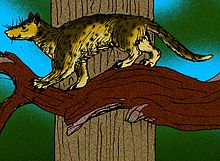- Miacis
-
Miacis
Temporal range: Paleocene–Late Eocene [1]
Scientific classification Kingdom: Animalia Phylum: Chordata Subphylum: Vertebrata Class: Mammalia (unranked): Carnivoramorpha Superfamily: Miacoidea Genus: Miacis
Cope, 1872Type species †Miacis parvivorus Species - †M. australis
- †Miacis cognitus
- †M. deutschi
- †M. exiguus
- †M. gracilis
- †M. hargeri (Wortman, 1901)
- †M. hookwayi
- †M. latidens
- †"M." lushiensis
- †M. medius
- †M. parvivorus
- †M. petilus
- †M. rosei
- †M. sylvestris
- †"M." thailandicus
- †M. washakius
- †M. winkleri
The 'genus' Miacis contains extinct species of carnivorous mammals that appeared in the late Paleocene and continued through the Eocene. The genus Miacis is not monophyletic but a diverse collection of species that belong to the stemgroup within the Carnivoramorpha.[2] As such, most Miacis species belong to the group of early carnivores that represent the ancestors of the modern order, the crown-group Carnivora. However, the species Miacis cognitus is placed not in the stem-group but among the Caniformia,[3] one of the two suborders of the crown-group Carnivora.
Miacis species were five-clawed, about the size of a weasel (~30 cm), and lived on the North American and European continents. They retained some primitive characteristics such as low skulls, long slender bodies, long tails, and short legs. Miacis retained 44 teeth, although some reductions in this number were apparently in progress and some of the teeth were reduced in size.
The hind limbs were longer than the forelimbs, the pelvis was doglike in form and structure, and some specialized traits were present in the vertebrae. It had retractable claws, agile joints for climbing, and binocular vision. Miacis and related forms had brains that were relatively larger than those of the creodonts, and the larger brain size as compared with body size probably reflects an increase in intelligence.
Like many other early carnivoramorphans, it was well suited for an arboreal climbing lifestyle with needle sharp claws, and had limbs and joints that resemble those of modern carnivorans. Miacis was probably a very agile forest dweller that preyed upon smaller animals, such as small mammals, reptiles, and birds, and might have also have eaten eggs and fruits.[4]
References
- ^ Heinrich, R.E.; Strait, S.G.; Houde, P. (2008). "Earliest Eocene Miacidae (Mammalia: Carnivora) from northwestern Wyoming". Journal of Paleontology 82 (1): 154–162. doi:10.1666/05-118.1.
- ^ Wesley-Hunt, G.D.; Flynn J.J. (2005). Phylogeny of the Carnivora: Basal Relationships Among the Carnivoramorphans, and Assessment of the Position of 'Miacoidea' Relative to Carnivora. Journal of Systematic Paleontology, 3: 1-28. DOI:10.1017/S1477201904001518
- ^ Spaulding, M.; Flynn J.J.; Stucky, R.K. (2010) Anew basal Carnivoramorphan (Mammalia) from the ‘Bridger B’ (Black’s Fork Member, Bridger Formation, Bridgerian NALMA, Middel Eocene) of Wyoming, USA. Paleontology 53: 815-832. DOI: 10.1111/j.1475-4983.2010.00963.x
- ^ Palmer, D., ed (1999). The Marshall Illustrated Encyclopedia of Dinosaurs and Prehistoric Animals. London: Marshall Editions. p. 214. ISBN 1-84028-152-9.

This prehistoric mammal-related article is a stub. You can help Wikipedia by expanding it.
